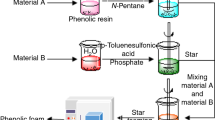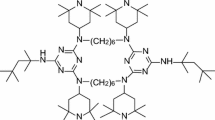Abstract
Dicyandiamide was used as a toughening agent to modify the brittleness of the phenolic foam. The effects of dicyandiamide on mechanical and flame-retardant properties of phenolic foam were studied by compressive strength, tensile strength, scanning electron microscopy (SEM), UL-94, limited oxygen index (LOI), TG, and cone calorimeter (CONE). The apparent density and SEM results showed that the addition of dicyandiamide can decrease the apparent density of phenolic foam. The compressive, impact test results showed that the incorporation of dicyandiamide into PF dramatically improved the compressive strength, impact strength, indicating the excellent toughening effect of dicyandiamide. The LOI of dicyandiamide-modified phenolic foams remained a high value, and the UL-94 results showed all samples can pass V-0 rating. The modified PF has the slightly lower degradation temperatures but a higher char yield. CONE data indicated that the rate of heat release, total heat release, mass loss rate of the modified PF are decreased compared with that of pure PF, indicating that the modified foams had better flame-retardant performance.










Similar content being viewed by others
References
Lei S, Guo Q, Shi J, Liu L. Preparation of phenolic-based carbon foam with controllable pore structure and high compressive strength. Carbon. 2010;48:2644–6.
Lei S, Guo Q, Zhang DQ. Preparation and properties of the phenolic foams with controllable nanometer pore structure. J Appl Polym Sci. 2010;117(6):3545–50.
Sarier N, Onder E. Thermal insulation capability of PEG-containing polyurethane foams. Thermochim Acta. 2008;475:15–21.
Ozkan DB, Onan C. Optimization of insulation thickness for different glazing areas in buildings for various climatic regions in Turkey. Appl. Energy. 2011;88(4):1331–42.
Rangari VK, Hassan TA, Zhou YX, Mahfuz H. Cloisite clay-infused phenolic foam nanocomposites. J Appl Polym Sci. 2007;103(1):308–14.
Wei D, Li D, Zhang L, Zhao Z, Ao Y. Study on phenolic resin foam modified by montmorillonite and carbon fibers. Procedia Eng. 2012;27:374–83.
Auad ML, Zhao L, Shen H, Nutt SR, Sorathia U. Flammability properties and mechanical performance of epoxy modified phenolic foams. J Appl Polym Sci. 2007;104:1399–407.
Urszula S, Bogumiła K, Sławomira P, Sylwia C. Preparation and characterization of carbon foams derived from cyanate esters and cyanate/epoxy copolymers. J Therm Anal Calorim. 2015;122(1):271–9.
Manuela TN, Cornelia V. Influence of the nanoparticle type on the thermal decomposition of the green starch/poly(vinyl alcohol)/montmorillonite nanocomposites. J Therm Anal Calorim. 2013;111(3):1903–19.
Yang H, Wang X, Yu B, Hu Y. A novel polyurethane prepolymer as toughening agent: preparation characterization, and its influence on mechanical and flame retardant properties of phenolic foam. J Appl Polym Sci. 2013;129:2720–8.
Yuan H, Xing W, Yang H, Song L, Hua Y, Yeoh GH. Mechanical and thermal properties of phenolic/glass fiber foam modified with phosphorus containing polyurethane prepolymer. Polym Int. 2013;62:273–9.
Bian XC, Tang JH, Li ZM, Lu ZY, Lu A. Dependence of flame-retardant properties on density of expandable graphite filled rigid polyurethane foam. J Appl Polym Sci. 2007;104:3347–55.
Giraud S, Bourbigot S, Rochery M. Flame behavior of cotton coated with polyurethane containing microencapsulated flame retardant agent. J Ind Text. 2001;31:11–26.
Streckova M, Sopcak T, Medvecky L, Bures RJ. Preparation, chemical and mechanical properties of microcomposite materials based on Fe powder and phenol-formaldehyde resin. Chem Eng J. 2012;180:343–53.
Wei P, Hao J, Du J, Wang J. An investigation on synergism of an intumescent flame retardant based on silica and alumina. J Fire Sci. 2003;21:17–28.
Babrauskas V, Grayson SJ. Heat release in fires. London: Elsevier Science Publishers Ltd; 1992.
Jenny A, Fabio C, Serge B, Giulio M. Thermal and flame retardant properties of ethylene vinyl acetate copolymers containing deoxyribose nucleic acid or ammonium polyphosphate. J Therm Anal Calorim. 2015;122(2):705–15.
Gao M, Wu W, Yan Y. Thermal degradation and flame retardancy of epoxy resins containing intumescent flame retardant. J Therm Anal Calorim. 2009;95(2):605–8.
Gao M, Wu W, Wu F. Thermal degradation and smoke suspension of cotton cellulose modified with THPC and its lanthanide metal complexes. J Therm Anal Calorim. 2009;98(1):245–51.
Acknowledgements
The work was supported by the fundamental research funds for the Central Universities of China (3142013102, 3142015021).
Author information
Authors and Affiliations
Corresponding author
Rights and permissions
About this article
Cite this article
Gao, M., Wu, W., Wang, Y. et al. Phenolic foam modified with dicyandiamide as toughening agent. J Therm Anal Calorim 124, 189–195 (2016). https://doi.org/10.1007/s10973-015-5156-1
Received:
Accepted:
Published:
Issue Date:
DOI: https://doi.org/10.1007/s10973-015-5156-1




